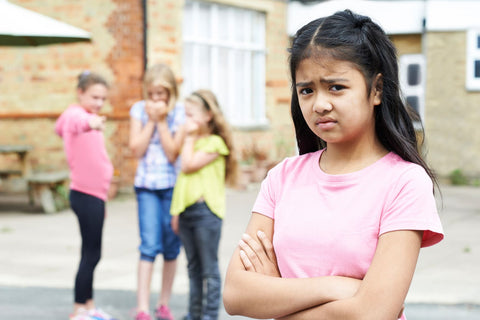Managing Bullying Behavior
Blog · Mar 08, 2019

Tears on the Playground
Sarah comes to you at recess. “Mariah is teasing me again,” she says, tears in her eyes. You comfort her, and soon, the entire story comes out. Mariah has been slipping mean notes into Sarah’s backpack, and pushing her on the stairs as they walk from class to lunch. The other girls in the class refused Sarah’s birthday party invitation at Mariah’s urging. As Sarah talks, you know right away that this is a typical example of bullying behavior—unwanted aggressive behavior that is repeated over time.
Bullying can be direct, Mariah was teasing Sarah, or indirect, Mariah spread rumors about Sarah. It can be physical (pushing), verbal (name calling), relational (trying to harm Sarah’s relationships with the other girls), and include damage to property. Bullying can happen in any place, even online.
Bullying is not always just one person. It can be a group of children working together to harass someone else.
Bullying vs. Teasing
We hear about bullying so much today that we feel we don’t need a definition, but understanding what bullying is and differentiating it from disagreements or friendly joking is essential to preparing children for the complex social environments they will encounter in life.
The perpetual discussion about bullying behavior in schools and online has produced an unexpected consequence whereupon every conflict is labelled bullying and treated as such. In this environment, children do not develop the capacity to resolve conflict themselves, and they don’t develop the healthy coping strategies to manage stress and other emotions.
Not all conflict is bullying. Bullying is not a single fight or online argument. It is natural for children to disagree and to argue with each other. Children equipped with the skills and strategies to manage those conflicts before they escalate into a fight or violence resolve those differences peacefully and emerge with the confidence to advocate for their needs and opinions in the future.
Building a Safe and Supportive Learning Environment
Bullying behavior in the school affects the learning experience for all students. Students who are the targets of bullying behavior don’t feel comfortable at school and, as a result, may withdraw from school and learning. Students who bully others may also feel disconnected from school and act out because they don’t know a better way to manage those feelings. Indeed, they may not recognize their behavior to be bullying. Witnesses to bullying behavior may not want to come to school because they feel powerless to stop the bullying they see happening.
Roughly a third of students reports being bullied at school. Nine percent report being bullied online while a majority report witnessing bullying. However, adults need to be vigilant as less than a third of students who are bullied report it to an adult. Most bullying happens during middle school, when students are likely to experience social or verbal bullying.
 Most of the time, bullying behavior stops when witnesses stand up and say something. Building a culture within the school that rejects bullying behavior and supports those students targeted by bullying behavior minimizes the reach and power of bullying. Talking to students about bullying and helping them recognize bullying behavior and encouraging them to and speak up when they witness it, together with clear expectations of peaceful behavior in school promotes a safe and productive learning environment.
Most of the time, bullying behavior stops when witnesses stand up and say something. Building a culture within the school that rejects bullying behavior and supports those students targeted by bullying behavior minimizes the reach and power of bullying. Talking to students about bullying and helping them recognize bullying behavior and encouraging them to and speak up when they witness it, together with clear expectations of peaceful behavior in school promotes a safe and productive learning environment.
Children who can recognize the difference between everyday conflict and bullying behavior and respond accordingly, are more self-aware and socially aware and prepared to respond appropriately. Together with the development of emotion management skills and effective communication skills, regular reinforcement and positive development of conflict resolution skills and social emotional capacity builds resiliency to prepare children and adolescents for the challenges and stresses they will face in high school, college, and beyond.